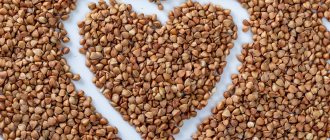How to choose quality cereals
Before you figure out how to store buckwheat, you need to choose it correctly. When choosing cereal in a store, you are faced with several varieties:
- Yadritsa - grains in the form of pyramids. Used for cooking for half an hour.
- Prodel - crushed kernels, cooks faster, 15-20 minutes is enough.
- Green – unprocessed buckwheat, can be steamed with boiling water and sprouted.
- Flakes, Smolensk - highly crushed, does not require cooking, steamed with boiling water or hot milk.
- Flour is ground grain used for baking and making drinks.
In the store, pay attention to the following nuances:
- Choose cereals without debris, husk residues, pebbles, bugs and other insects. All this is visible through the transparent packaging.
- The grains must be the same size. Otherwise, it will not be possible to cook crumbly porridge: part of it will be ready, while the other will remain raw.
- Give preference to cereals packaged in hermetically sealed bags. Weighed products are more quickly affected by pests.
- The dark color of buckwheat indicates that it has been fried. This means that some of the beneficial substances have already been lost.
- It is advisable to choose a product of the highest and first grade. It is not treated with pesticides during cultivation, so it can be safely given to children.
Do you know that…
According to GOST, buckwheat does not have the “Extra” grade, etc. These are inventions of unscrupulous producers. There is the highest, first, second and third. But the product has no varieties at all.
Varieties of buckwheat
Useful properties of boiled buckwheat
Buckwheat steamed with water or doused with kefir is more beneficial for health. During cooking, some of the substances beneficial to the body are lost. But if you eat buckwheat every day, even boiled, your health will improve significantly.
Buckwheat contains proteins, fats, complex carbohydrates, dietary fiber, mono- and disaccharides, and starch. The chemical composition also contains the most important vitamins: B9, B8, B6, B3, B2, B1, which are needed for carbohydrate and water-salt, protein and lipid metabolism. They are involved in the synthesis of hormones and in the process of hematopoiesis. B vitamins have a beneficial effect on vision and brain activity.
Vitamin P (rutin) contained in cereals has a positive effect on the functioning of the heart and thyroid gland, increases the elasticity of artery walls, and has anti-inflammatory and bactericidal effects.
Buckwheat does not contain gluten, so it is suitable for people intolerant to this substance. Fiber in cereals helps to effectively cleanse the intestines and normalize digestion.
It is impossible to feel normal without the amino acids that are present in Greek: methionine, tryptophan, threonine, lysine, arginine.
All vitamins, minerals and other beneficial elements are found in buckwheat in a balanced composition and form that is easily digestible for the body. That is why buckwheat porridge is considered useful for children and adults.
Storing buckwheat
The older generation, having experienced the hardships of life, is unlikely to get rid of the habit of storing food for future use. Many people think that buckwheat is stored for a long time, so in order to avoid another price increase, they buy more of it. But that's not true. The shelf life of buckwheat, like other cereals, is limited.
In a closed package
Conventionally, buckwheat is stored for 2 years. Each variety of buckwheat product has its own shelf life:
- core – 15 months for the Far East, North Caucasus, Lower Volga region and 20 months for other regions;
- completed - 14 and 18 months, respectively.
Buckwheat retains its beneficial properties throughout its shelf life in full, provided:
- hermetically sealed packaging;
- dark, dry room;
- humidity not exceeding 70%;
- air temperature 25 degrees.
The expiration date of buckwheat can be found from the product labeling on the package. In addition, the manufacturer indicates the year and month the product was packaged. When making a purchase, check this information. The date stamped on the affixed label should alert you. After all, it is not known in what conditions the cereal was stored, and how much time passed before it was packaged.
Note to the hostess
When storing cereals beyond their expiration date, it is recommended to take a sample of porridge cooked from it at least once a month, thereby determining the possibility of its further use.
Buckwheat grains contain 18 essential amino acids, and the concentration of microelements and vitamins is almost 3 times higher than in other grains
In open packaging and by weight
After opening the original packaging, the shelf life of the cereal is reduced several times:
- kernel – 4 months;
- completed - 3 months;
- green – 2 months.
Now it is impossible to make claims to the manufacturer about the spoilage of buckwheat. All responsibility for the safety of the product lies with the consumer.
How to store buckwheat at home:
- Remove the cereal from the store packaging and place it in glass, plastic, or metal containers intended for bulk products.
- To extend shelf life, dry the product in the oven or in a frying pan for 8-10 minutes at moderate temperature. Be careful not to overcook the grain, otherwise the nutrients will be destroyed. You can also use the freezer for processing, placing buckwheat there for a day.
- You can remove excess moisture from a container with cereal using kitchen salt. To do this, tie the salt in a piece of gauze and place it at the bottom of the jar.
- Slices of unpeeled garlic and 2-3 bay leaves will help repel insects. Dried lemon peel and chestnut fruits have the same properties. Just stuff them into the buckwheat container.
- There is another trick used to store grain at home. These are linen bags that need to be boiled in a saturated salt solution. Bugs do not grow in such bags, and the contents remain dry.
- It is recommended to find a dry place for containers with buckwheat, away from objects and products that emit strong odors. Otherwise, the cereal will absorb the aromas, and you will have to eat porridge that tastes like coffee, spices, or gasoline.
- There are no restrictions related to lighting in regulatory documents. But we must remember that direct sunlight not only illuminates, but also increases the temperature. The sun should be avoided.
Buckwheat must be present in the diet of diabetics, athletes, pregnant women, vegetarians and dieters
We answer the question: is it possible to store buckwheat on the balcony in winter?
It is not advisable to store buckwheat on the balcony for the following reasons:
- temperature difference;
- humidity changes depending on the weather;
- sunlight has a negative effect.
What affects the freshness of a product?
To get the maximum benefit from the boiled product, it is important to choose the right buckwheat. Give preference to buckwheat in packaged bags without black unprocessed grains, sticks, or other grains. Otherwise the porridge will quickly spoil. If there are bugs in raw cereals, such buckwheat is unsuitable for consumption. Production time is no less important. The older the cereal, the less useful elements are preserved in it.
Raw cereals are stored in closed packaging for no longer than 2 years. It is important to observe storage conditions:
- dark room;
- air humidity no more than 70%;
- air temperature no more than +25°C.
Ready porridge should not be left on the table in direct sunlight. After defrosting, reheat only the amount of food you can consume at one time. The product remaining in the plate cannot be reheated, as this promotes the proliferation of pathogenic microbes. It is recommended to throw away such leftover food to avoid poisoning.
Signs of spoiled cereal
The quality of buckwheat is determined by examining several spoons of cereal. Pay attention to:
- color - the grains are covered with a whitish coating or mold;
- smell - mustiness and rancidity appear due to outdated fat;
- taste – buckwheat is bitter if you chew 1-2 grains;
- the cereal falls off, forming lumps;
- living creatures appear - bugs, worms, moths.
These signs indicate that the product is not suitable for food. It should be thrown away.
Tip of the day
To check the quality of grain, use this method: grind a spoonful of buckwheat and heat it in a water bath. An unpleasant odor will manifest itself.
If the tests are passed and nothing suspicious is found, it makes sense to cook a portion of porridge and try it.
When should you not eat buckwheat?
The shelf life of the product depends on the preparation method and additives. Buckwheat, cooked in water without oil, lasts the longest. Ready-made porridge does not tolerate heat. At temperatures from +8°C and above, bacteria begin to rapidly multiply in it. You can tell if buckwheat has gone bad:
- by unpleasant odor;
- sour and rancid taste;
- mold;
- mucus.
The presence of at least one of the listed signs indicates that the porridge should not be consumed. There is no need to try to save the product by boiling, frying or using seasonings.
Storing boiled buckwheat
The kernels are used to make a delicious crumbly porridge, which also needs to be properly preserved. Lack of time forces many housewives to prepare food with a supply of several days. You need to figure out how long boiled buckwheat can be stored.
Cooked porridge on the stove will spoil within 24 hours. This is clear from the following signs:
- a sour smell appears;
- mucus forms at the bottom of the pan;
- the surface becomes moldy.
There are several ways to preserve boiled buckwheat:
- placing in the refrigerator;
- placing it on a cold balcony or loggia;
- frozen in the freezer.
Buckwheat goes well with dry and fresh fruits, vegetables, mushrooms, nuts, meat and milk. Just not with sugar, which neutralizes all its beneficial properties.
In the refrigerator, the finished product retains its benefits for no more than 3 days. At the same time, oil, vegetables, and meat are not added to the porridge. Observe the following conditions:
- Cover the container with porridge with a lid and place it on the refrigerator shelf.
- Maintain the temperature no higher than 4 degrees Celsius.
- Reheat, reserving desired portion.
If it is winter outside, then the pan can be taken out to the balcony or loggia. There the porridge will stand painlessly for 3 days at a temperature of 4 degrees, and at minus for a week.
Note to the hostess
You need to make sure that the sun does not fall on the container with porridge. This causes the pan to heat up, causing the product to spoil faster.
How to tell if buckwheat has gone bad
If storage conditions are violated or expiration dates are exceeded, boiled cereal may deteriorate. Signs of an unedible product:
- sour or musty odor;
- slippery surface;
- translucent threads or colored mold spots;
- unpleasant taste.
This porridge can be given to birds or boiled for 30 minutes and fed to pets. Consumption of a spoiled product by a person can lead to indigestion, food poisoning and other unpleasant consequences.
Boiled buckwheat is best stored in the refrigerator; the shelf life reaches 3 days. In warm weather, the eating time is reduced to several hours. By freezing the porridge can be preserved for up to 3 weeks.
How often do you cook buckwheat? Are there problems with storage? Share the article with friends and acquaintances on social networks, save it to your page.
How long does cooked buckwheat last in the refrigerator?
Of course, any culinary specialist will say that it is much tastier to eat fresh, just cooked porridge. But it happens that after a meal there are food leftovers and they can and should be stored, shouldn’t they be thrown away right away? If you are a porridge lover, you will be interested to know how long boiled buckwheat lasts in the refrigerator.
If you put the porridge in the refrigerator, it is advisable to eat it within two days from the moment of preparation. But at high temperatures, especially indoors, the freshness of the porridge will remain for a couple of hours.
Some housewives are now surprised, because it happens that porridge can retain its freshness for a week. You can eat it, but the benefit will be zero. The longer boiled buckwheat sits in the refrigerator, the less beneficial properties it will retain. You can simply satisfy your hunger.
The component composition is preserved for 48-72 hours from the moment of preparation. And if you have added any additional products, then it is better to consume buckwheat porridge the next day at most.
Buckwheat porridge can be left on the balcony during the cold season. It is important that the dish is not exposed to sunlight.
On a note! The optimal temperature for storing cooked buckwheat is considered to be +4°.
By the way, buckwheat porridge can even be placed in the freezer. If frozen, the prepared treat will be stored a little longer and will retain all its usefulness. You just need to defrost the porridge, heat it up and serve it. The taste will remain virtually unchanged.
Useful tips
Experienced housewives share their recommendations for choosing and storing this product:
- You can store buckwheat for a long time only if the grain is of high quality. It should not contain pebbles, husks, insects, grains should be approximately equal in size. Buy buckwheat in transparent packages - it’s easier to assess the quality of the product
- Keep cereals out of direct sunlight.
- A small bag of salt will help protect the cereal from excess moisture.
- Heat-treat the cereal before placing it in a storage container. 8-10 minutes in the pan will be enough. It is important that buckwheat is not overcooked, otherwise it will lose all its beneficial qualities.
To ensure that cooked buckwheat is crumbly, follow the following algorithm:
- Place the cereal in a saucepan, pour water into it so that it slightly covers the product.
- Place the container over medium heat and wait until the water begins to boil.
- Then reduce the heat, add seasonings and salt to the pan. Cook the buckwheat for about 10-15 minutes.
- Remove the pan and cover it with a thick cloth such as a towel. Leave the dish for 15-30 minutes.
Does the product have an expiration date?
Like any other product, buckwheat has an expiration date. It guarantees:
- Compliance of the product being sold with quality standards.
- A prohibition for the seller or manufacturer to sell the product after the expiration date.
If the requirements are violated, the seller is liable, even criminally. According to GOST R 55290-2012, the manufacturer is required to set an expiration date. Calculated from the date of completion of the product manufacturing process, according to technological standards.
One of the options may be specified:
- The period of time during which the product is suitable for use. For example, “2 years from the date of manufacture.”
- Date until which it can be used without harm to health. For example, “Expires until (day, month, year).”
SanPiN 2.3.2.1324-03 establishes a rule according to which, in the case of packaging in consumer packaging during the sales process (for example, when selling by weight in a retail establishment), the shelf life should not exceed that indicated on the transport container. It is counted from the date of manufacture, and not from the date of packaging.
Freezer storage
In addition to the refrigerator, boiled buckwheat can be stored in the freezer. To do this, the porridge must be placed in a food container with a lid. As needed, it is defrosted, reheated and served. This is very convenient when there is no time at all for cooking or there is a lot of ready-made buckwheat porridge and there is no way to eat it in 3-7 days. In addition, freezing allows you to preserve most of the nutrients. Ready frozen buckwheat lasts 2-3 weeks.
It is better to defrost buckwheat gradually. That is, first transfer it from the freezer to the refrigerator, wait until it turns from icy back into crumbly porridge, and then reheat it.
A few words about the value of the product
The only people who should not eat buckwheat are allergy sufferers. But for people who have problems with cholesterol in the blood, cereal is very useful. After all, it improves immunity and has many beneficial qualities.
In addition, buckwheat is valued for its high iron content, which is known to affect the saturation of cells with oxygen. In addition, porridge is rich in PP vitamins, which strengthen the nervous system and counteract thrombosis.
So, in Greek there are:
- phosphorus;
- potassium;
- copper;
- calcium and zinc.
Slow-acting buckwheat carbohydrates are useful for people suffering from high blood sugar levels, because... when split, they do not cause sudden spikes in insulin. Meanwhile, buckwheat also contains a lot of protein, which is less toxic and more accessible to the body than animal protein.
However, you should know that the less you cook buckwheat porridge, the more vitamins it will retain. It is also not recommended to cook it with the addition of milk, honey and sugar. But vegetables and fruits can be added to it.
What happens to cereal over time?
Over time, buckwheat loses its beneficial properties. In the kitchen, humidity and temperature are often elevated, which has a negative impact.
With high humidity, the cereal cakes, sticks together into lumps, and fungus and mold form on it.
At high temperatures, insect pest larvae become active. The product becomes infested with these insects. During long-term storage, a rancid taste and smell appears. This happens because the grains secrete fats, which deteriorate over time.
Quality should be checked regularly. For this:
- Pour some of the product from the container onto a plate and inspect.
- Smell the grains.
- Check for any lumps.
- Inspect for insects.
- Determine if mold has appeared.
In case of unsatisfactory results, the product must be discarded and cannot be eaten. If everything is visually in order, the following measures should be taken:
- Crush and steam a small amount. Determine if there is an unpleasant odor.
- Chew the grains. There should be no rancid or musty taste.
- Boil some porridge and check the taste.
It can be eaten only in the absence of all negative signs.
Influencing factors
Buckwheat can truly be called one of the healthiest cereals. Its preparation takes literally a third of an hour. And in some cases there is no need to even cook buckwheat. It is enough to fill it with lukewarm water or kefir at room temperature. In a few hours, the kernels will swell and be ready for use.
Component composition:
- ferrum;
- cellulose;
- retinol;
- manganese;
- selenium;
- vitamins from group B;
- calcium;
- tocopherol;
- magnesium;
- nicotinic acid, etc.
If you want all these components to remain in buckwheat after it has been cooked, you need to take into account the factors that affect the shelf life of the cereal.
Main factors:
- quality of cereal;
- package;
- best before date.
As a rule, the manufacturer indicates on the package information about the date of packaging of buckwheat and its shelf life. Do not choose cereals that have been manufactured for a long time. Firstly, it may have a bitter taste. Secondly, the longer the cereal is stored, the less useful it remains.
The shelf life of cereals, both raw and boiled, will be affected by packaging. It must be hermetically sealed and complete. In the transparent plastic packaging you can see the quality of the kernels. Too much garbage indicates that the grain is not of very high quality. It is better to give preference to selected kernels.
Let's talk about the benefits
It is best to eat buckwheat porridge immediately after cooking. If you want to preserve its beneficial properties as much as possible and extend its shelf life, store cooked buckwheat in its pure form without any additives. As already mentioned, the presence of oil, meat components and other ingredients in porridge significantly reduces its shelf life for consumption.
Buckwheat that has just been cooked has the most benefits. Of course, during the heat treatment some part of the micro- and macroelements is lost, but it is insignificant.
Benefit:
- normalization of intestinal motility;
- improving the functioning of the heart muscle;
- strengthening vascular walls;
- helping to increase hemoglobin levels;
- improving the functioning of the digestive tract;
- replenishment of folic acid deficiency.
We have already discussed how diverse the component composition of buckwheat is. B complex vitamins help normalize the functioning of the nervous system. But potassium and magnesium are the best helpers for the heart muscle and blood vessels. Few people know that buckwheat contains a sufficient amount of protein of plant origin. There are approximately 13 grams in a 100-gram serving. Agree, a lot. That is why buckwheat is used as a main dish during monotonous diets.
On a note! Some traditional healers are convinced that regular consumption of buckwheat porridge helps to cope with insomnia and get rid of neuroses and unreasonable anxiety.
In order to gain exceptional benefits, you should pay special attention to the choice of core. It is best to give preference to selected varieties. Thanks to the transparent packaging, we can always determine the condition of buckwheat. Carefully study the labeling and information on the packaging. If buckwheat has been stored on a store shelf for a long time, it is better not to buy it.
It is important to follow the cooking rules. Doctors believe that it is best to steam buckwheat kernels with hot water or fermented milk drinks. Such porridge will have the most benefits, although it will not be stored for long, even in the refrigerator.
Under what conditions should it be stored?
Buckwheat should be stored at a temperature of +5°C -+15°C and a humidity of 60%.
After returning from the store, it is best to transfer the cereal to a suitable container:
- in a closed glass jar,
- plastic dishes;
- canvas bag.
In this case, buckwheat should be stored in dark, dry rooms, protected from sunlight.
When choosing a place for buckwheat, you need to remember that this cereal can quickly absorb the odors of the environment. Therefore, it must be stored separately from spices and products with a strong aroma.
To prevent the cereal from becoming a home for insects, the canvas bag in which it is going to be kept is first soaked in a saline solution (1:4), and then dried well. You can also put 2 - 3 garlic cloves or bay leaves in the cereal, which will help repel bugs. Dried lemon zest or chestnut peel are suitable for the same purposes.
A fabric bag of salt placed among the buckwheat will help remove excess moisture.










